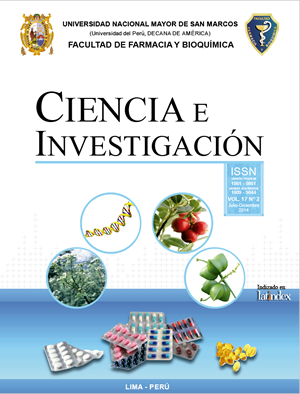Chemistry and technological-nutricional assessment of "papaya height" (Carica pubescens)
DOI:
https://doi.org/10.15381/ci.v17i2.13595Keywords:
Papaya height, chemical composition, nutritional value, technological and nutritional valueAbstract
Chemical composition and technological and nutritional value of "papaya height"(Carica pubescens) also known as "Arequipa papaya" was studied using official AOAC methods and adapting the standard procedure of food technology. The samples were analyzed for physico-chemical proximal composition and content of vitamins and minerals by VIS spectrophotometric method through oxidation-reduction and atomic absorption spectrophotometry. Nutritional technological study was conducted through the elaboration of a processed product to extend the shelf life, the sensory evaluation was performed by quantitative descriptive analysis using hedonic scale and microbiological testing according to Peruvian technical norm NTP 203,108. On average the most relevant results per hundred grams of edible portion were: pH 6,7 to 6,8; acidity 0,08 to 0,09; water 87,7 to 87,54 g; protein 0,49 to 0,52 g; total minerals from 0,32 to 0,47 g; fiber 1,76 to 1,97 g; reducing sugars direct 7,36 to 9,52 g; carbohydrates 9,52 to 9,56 g. Vitamin C 30-37 mg; β-carotene 3783-2493 µg. On average, the content of vitamin C represents 83,7% of daily intakes recommended; the β-carotene is equivalent to 261 μg retinol, representing 64 and 44% of the daily recommendations for vitamin A to children 4-8 years of age and adolescents, respectively. In processed product, data of sensory analysis not showed differences in the categories evaluated among newly developed products and products after two months of storage at room temperature products and microbiological indicators remained the same. Was evidenced that the fruit can make significant contributions of vitamin C and β-carotene for human consumption and having technological and nutritional potential to developing a product for the purpose of extending its useful life fit for human consumption.Downloads
Published
2014-12-31
Issue
Section
Artículos Originales
License
Copyright (c) 2014 Eloisa Hernández, Norma Carlos, Luis Inostroza, Nelson Bautista, Rosa Byrne, Ana Alencastre, María Peña, Salomón Sueros

This work is licensed under a Creative Commons Attribution-NonCommercial-ShareAlike 4.0 International License.
LOS AUTORES RETIENEN SUS DERECHOS:
- Los autores retienen sus derechos de marca y patente, y tambien sobre cualquier proceso o procedimiento descrito en el artículo.
- Los autores retienen el derecho de compartir, copiar, distribuir, ejecutar y comunicar públicamente el articulo publicado en la Revista Ciencia e Investigación (por ejemplo, colocarlo en un repositorio institucional o publicarlo en un libro), con un reconocimiento de su publicación inicial en la Revista Ciencia e Investigación.
- Los autores retienen el derecho a hacer una posterior publicación de su trabajo, de utilizar el artículo o cualquier parte de aquel (por ejemplo: una compilación de sus trabajos, notas para conferencias, tesis, o para un libro), siempre que indiquen la fuente de publicación (autores del trabajo, revista, volumen, numero y fecha).
How to Cite
1.
Hernández E, Carlos N, Inostroza L, Bautista N, Byrne R, Alencastre A, et al. Chemistry and technological-nutricional assessment of "papaya height" (Carica pubescens). Ciencia e investigación [Internet]. 2014 Dec. 31 [cited 2025 Jun. 5];17(2):88-91. Available from: https://revistasinvestigacion.unmsm.edu.pe/index.php/farma/article/view/13595






